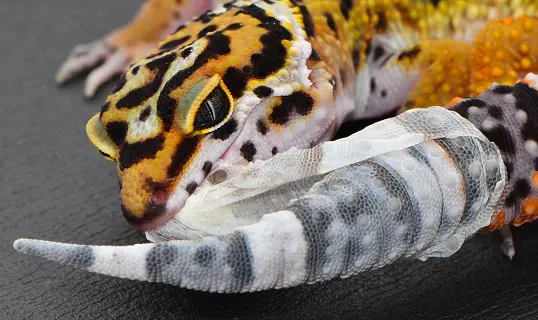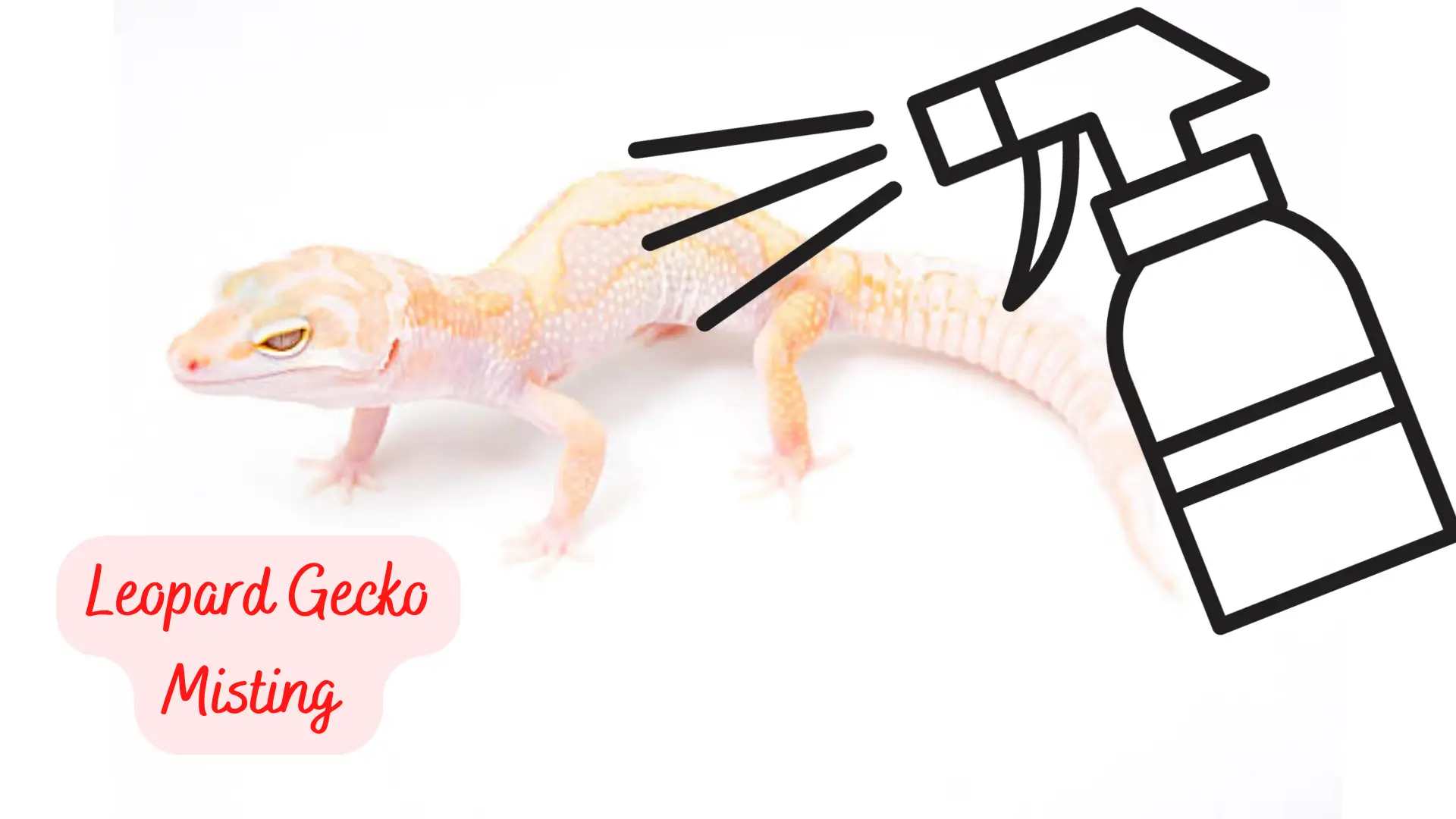Do leopard geckos need misting? Yes! Do I need to moist my leopard gecko’s cage? Yes! If you have a leopard gecko, you need to ensure that it has adequate moisture to meet its needs, and you should give short bursts of mist, either directly on its skin or in its cage.
When you are just starting as a new Leopard gecko owner, you are probably looking to find a way to make sure your gecko stays comfortable, well-hydrated, and at the right temperature within its habitat.
This article will discuss safe practices on how to mist a leopard gecko while looking out for any health issues associated with excess moisture.
In this article
Do leopard geckos need misting?
Are you supposed to mist leopard geckos? Yes. Leopard Geckos are native to arid or semi-arid regions where the atmospheric moisture is often low. However, leopard geckos require some water to lower their body temperature and their physiological shedding process.
If you were wondering, should I spray my leopard gecko with water? Yes, you should. Geckos need to be misted twice a week to avoid stress, especially during shedding, and to keep them hydrated and in top condition.

If you don’t mist your leopard gecko and its habitat, your gecko will likely experience a stuck or partial shedding problem. Therefore, light misting your leopard gecko as it approaches its shedding period is recommended. However, only a small amount of spray is required. You should bear in mind that excessive misting could cause harm to your pet.
Is too much humidity bad for leopard geckos?
Humidity is a very sensitive aspect of the well-being of your leopard gecko. Many questions around this topic include: Do leopard geckos absorb water through their skin?
We do not have any authoritative literature supporting the claim that leopard geckos absorb water through their skin. However, the agreed fact is that water sprayed on their skin drips to their mouths for hydration, and it helps cool the lizard as it evaporates from the skin.
To ensure your leopard gecko’s humidity levels are never too high, it’s essential to regularly monitor the relative humidity in its habitat and avoid spraying too much water directly on the leopard gecko’s skin. High humidity levels can also lead to bacterial and fungal growth in tanks, which can cause health problems, including;
1. Respiratory illness
Knowing how to mist a leopard gecko is as good as feeding it. Excessive misting, especially directly on the leopard gecko’s skin, will cause the lizard to catch illnesses such as pneumonia.
Respiratory tract infections such as pneumonia are serious illnesses that can quickly lead to death. When you keep your pet leopard gecko in an environment too cold or humid, he will be at risk of developing pneumonia.
Some of the symptoms your leopard gecko may show when infected include;
- unusual discharges or mucus bubbles from the mouth and nose
- market difficulty breathing
- keeping its mouth open to breathe sufficiently
2. Gastrointestinal issues
Leopard geckos may have a gastrointestinal tract problem if they are sick or infested with parasites and fungi. Molds and mildew, being the causes of such infections, thrive in high humidity areas and, in our case, an excessively misted cage.
Leopard geckos with gastrointestinal tract infections will show signs such as;
- lack of appetite
- lethargy, and
- diarrhea
3. Skin infections.
Bacteria may invest your leopard gecko skin due to the conducive moist environment resulting from excessive direct misting.
Dermatitis/ blistering disease, also called rotting of the skin disease, is one of the many types of bacterial skin infection your leopard gecko may contract. The disease symptoms range from small lesions/ulcers on the skin to large open wounds resulting from ruptured blisters.
How do you mist a leopard gecko?
Having understood the risk of excessive misting of both your gecko and its habitat, of importance is to evaluate when misting is necessary.
If you only need to mist your gecko to aid in its shedding process, you must consider answering: How often do leopard geckos shed? Baby leopard geckos shed every one or two weeks, while adult geckos shed every four to eight weeks. This knowledge will help shed more light on what to do when your gecko is shedding and decide what misting method to use.
There are typically two misting methods:
1. Manual Spray-Bottle for Leopard Geckos Misting.
An inexpensive leopard gecko misting system is a manually misting system where a spray bottle is used. A small bottle or other containers with water and a nozzle attachment and pumping mechanism gets the job done.
The goal is for the leopard gecko to drink the droplets of water that flow down his head to help hydrate and shed his old skin.
2. Automated misting
It’s easy to become overwhelmed by the expectations of life, and it’s possible to forget to water your leopard gecko and its habitat. Leopard geckos are also nocturnal, making it challenging to mist them at night. This is where an automated leopard gecko misting system comes in.
Do leopard geckos need humidifiers? Yes. The best way to keep your leopard gecko from getting extremely dry or hot is to install an automatic misting system such as an automatic reptile humidifier with sensor.
The automatic misting system offers convenience, and you don’t have to worry about forgetting to mist. Without adequate moisture in the air or water to hydrate, leopard geckos can have various health problems, and they might lose their lives.
Do I need to moist my leopard gecko’s cage?
The primary goal of misting your leopard gecko’s habitat is to help control the humidity levels of the habitat so that your leopard gecko has adequate water and moisture.
If you have a suitable Leopard gecko moist hide, it allows you to create habitats that don’t require you to spray them with water constantly. So, do leopard geckos need a moist hide? Yes, your leopard gecko needs a moist hide for your convenience and prevents forgetting to mist altogether.
You can search for the best moist hide for leopard gecko on amazon and be advised on the ideal leopard gecko moist hide placement.
What kind of water is safe for leopard geckos misting?
To keep your geckos happy and healthy, you should provide them with clean, purified, or distilled water. These are safe and clean since they are free of contamination. Ideally, rainwater is the most natural source of leopard gecko drinking water and misting in the wild.
Is tap water safe for geckos? Tap water and bottled water are generally free of chemicals, but there’s no telling what might be lurking in them. It’s okay to use tap water for leopard gecko misting, provided that its primary source doesn’t contain chlorine and is purified.
What do you do with a dehydrated gecko?
Excessive misting or soaking the leopard gecko will not be ideal in this situation. Dehydrated Leopard geckos will require a constant supply of fresh water and humidity levels in their environment. To help your reptile in extreme dehydration, use an eyedropper or syringe to drip water onto its snout.
Below are some associated risks if you don’t practice sufficient leopard gecko misting.
1. Leopard gecko overheating:
The environment plays a significant role in leopard gecko temperature regulation. Misting with evaporation is a recommended method to cool down a leopard gecko tank. Your leopard gecko may die of overheating.
2. Shedding Complications:
A dry partial, or stuck shedding skin can be fatal or lead to permanent leopard gecko body deformities. Drying skin at the toes, for instance, will constrict blood flow leading to toe decay and eventually falling off.
Your guess is as good as mine if such drying, shedding skin occurs all over the body. You may lose your leopard gecko.
Leopard Gecko Type Probably You Never Heard Of. Buying a leopard gecko morph from a pet shop can be stressful and confusing. There are many different leopard gecko types, and they all look very different.
Conclusion.
The leopard geckos should be maintained in an environment where misting is done occasionally to help keep them cool, and hydrated and ease their shedding process. The most important thing to remember when caring for your leopard gecko is avoiding excessive misting and using purified water.
An automated leopard geckos misting system is a convenient way to help control your leopard gecko’s misting. It will keep your pet happy, keep him hydrated and offer you peace of mind.


